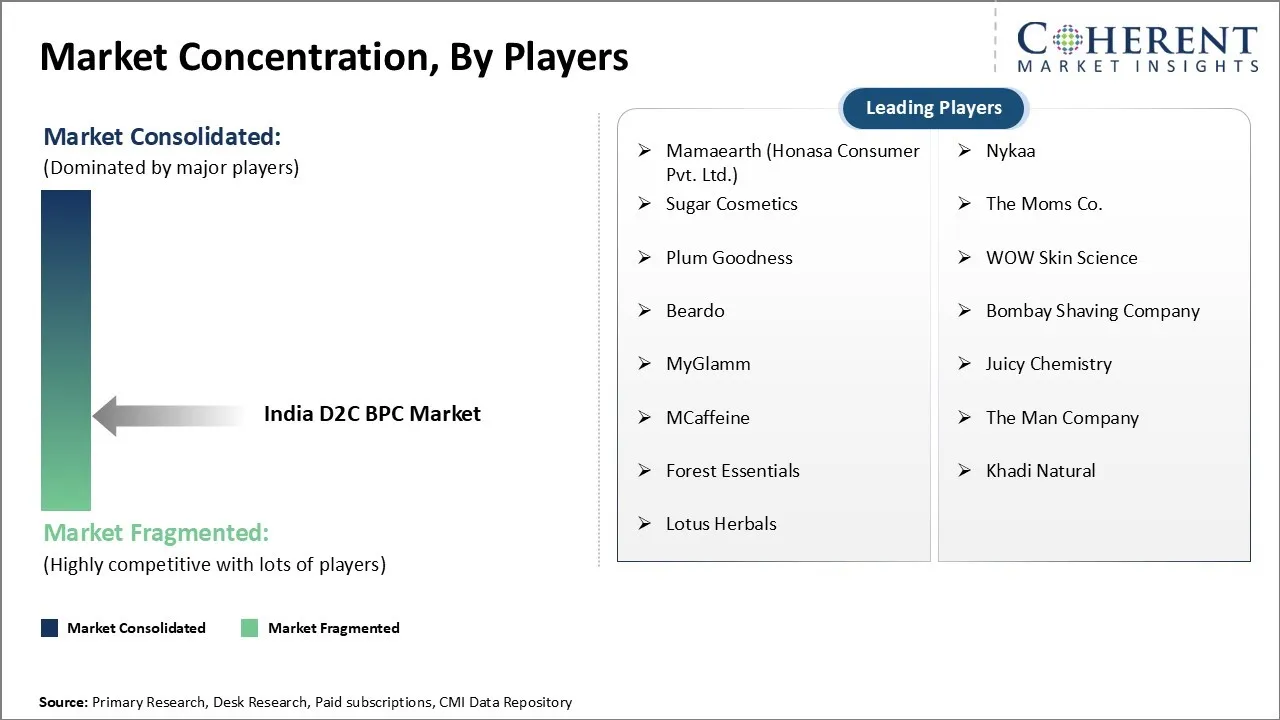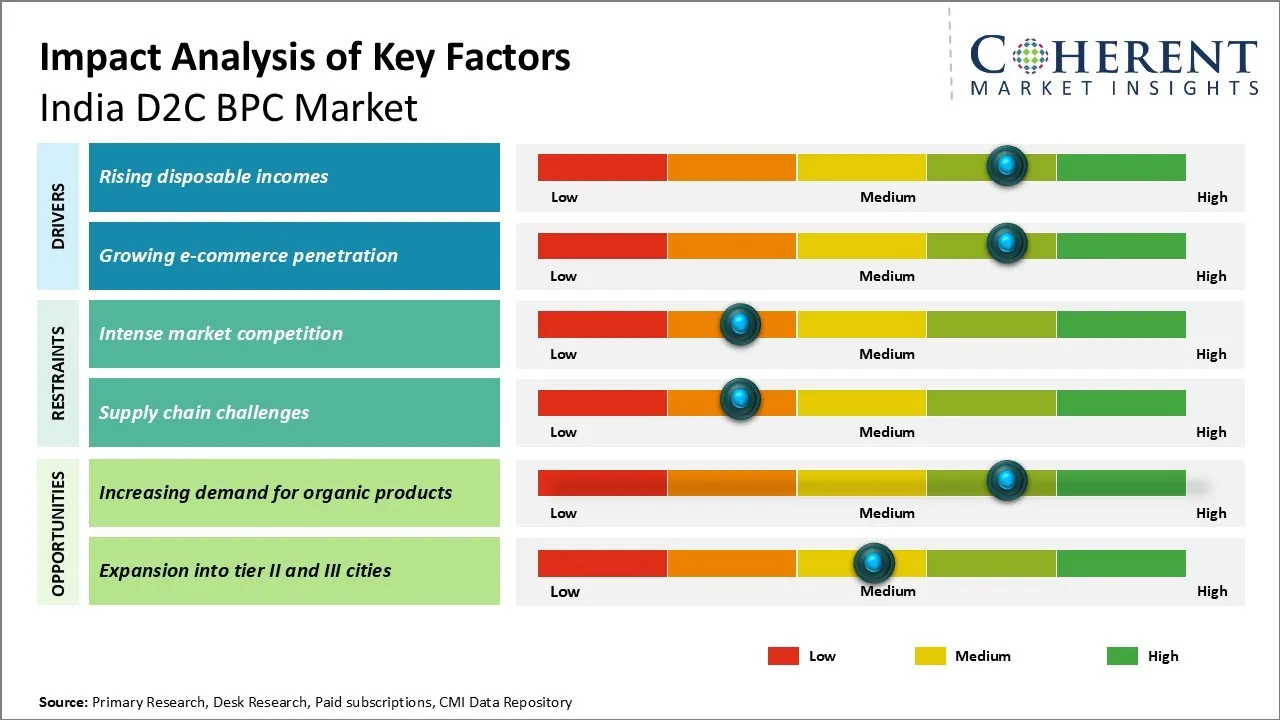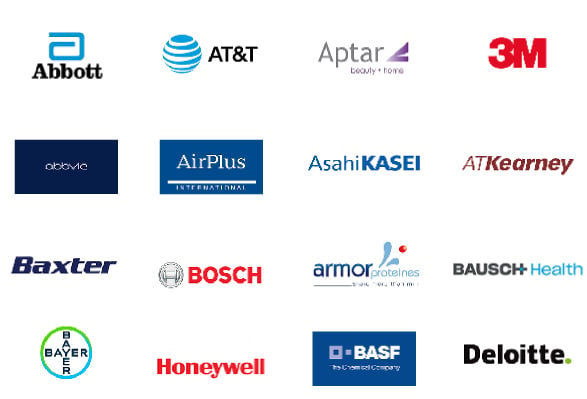The India D2C BPC Market is estimated to be valued at USD 4.09 Bn in 2025 and is expected to reach USD 35.92 Bn by 2032, exhibiting a compound annual growth rate (CAGR) of 36.4% from 2025 to 2032.
Key Takeaways of the India D2C BPC Market
Market Overview
The India D2C BPC market is witnessing rapid expansion, driven by the increasing adoption of e-commerce and social media marketing. Consumers are preferring D2C brands due to customizable products, transparent business practices, and direct engagement with brands. Rising digital penetration, growing disposable incomes, and a shift towards natural, organic, and clean beauty products are further fueling India D2C BPC market growth. While online channels dominate sales, D2C brands are expanding into offline retail stores and experience centers to enhance brand presence and customer trust.
Product Type Insights - Focus on Skin Health Drives the Demand for Skincare Products
The skincare products segment is expected to contribute the largest market share of 30.5% in 2025 in the India D2C BPC market due to growing awareness about the importance of skin health. Consumer interest in anti-aging products is surging as people seek to delay visible signs of aging and maintain healthy, youthful-looking skin. Indians across all age groups are paying closer attention to their skin issues like pigmentation, acne, dark spots, and fine lines. They want solutions tailored to their individual skin concerns rather than broad product categories.
D2C skincare brands are adept at formulating products based on specific skin types and concerns. Their potent, clinically-tested formulations address even challenging skin conditions like pigmentation and acne scars. Customers appreciate the transparency around ingredient sourcing and formulations. Through engaging content on social media, D2C brands also educate consumers about ingredients and routines for achieving their skin goals. They emphasize the value of personalized, research-backed skincare over one-size-fits-all departmental store products.
Changing lifestyles and pollution have heightened skin troubles for urban Indians. D2C brands fill this need with targeted solutions. Products containing soothing naturals, potent actives, and innovative textures gain huge trust. Affordability and the ability to purchase as needed for particular issues drive repeat purchases from customers loyal to such specialized yet affordable skincare. The demand for customization, transparency, and skin positivity will ensure the skincare products segment's lead in the future as well.
Distribution Type Insights - Online-only D2C Brands Dominate the Market Due to Convenience
Online-only D2C Brands dominate the India D2C BPC market with an estimated share of 63.86% in 2025. Convenience tops preferences for today's time-starved customers, driving the dominance of online-only D2C brands. Traditional multi-step brick-and-mortar shopping involves too much effort when efficient online options deliver what consumers need within days to their homes or offices. Online-first brands understand customer mindsets and offer seamless shopping, convenient payment options, and quick deliveries. Their innovative subscription models ensure uninterrupted skincare or other regimens without the bother of repetitive purchases.
Social media has transformed how Indians scout and buy brands. They extensively research products through engaging Instagram and Facebook pages before adding to cart. Here D2C brands excel with immersive brand stories and vibrant creator communities that cultivate loyal followers. Video reviews and tutorials published by influencers and customers themselves inspire confidence in buying unseen. Successful brands personalize the online experience through chat filters and support staff to make customers feel heard.
As digitization rises across B-cities and villages, online shopping will grow further for its simple, hassle-free nature. Omnichannel brands complement their websites and apps with selective stores only for touch-and-feel trials, not full purchases. Overall, online-focused models cater best to contemporary preferences and will lead distribution in the future as well.

Get actionable strategies to beat competition: Request sample copy
Top Strategies Followed by India D2C BPC Market Players
Emerging Startups – India D2C BPC Industry Ecosystem
Key Developments:
India D2C BPC Market Report Coverage
| Report Coverage | Details | ||
|---|---|---|---|
| Base Year: | 2024 | Market Size in 2025: | US$ 4.09 Bn |
| Historical Data for: | 2020 To 2023 | Forecast Period: | 2025 To 2032 |
| Forecast Period 2025 to 2032 CAGR: | 36.4% | 2032 Value Projection: | US$ 35.92 Bn |
| Geographies covered: |
|
||
| Segments covered: |
|
||
| Companies covered: |
Mamaearth (Honasa Consumer Pvt. Ltd.), Nykaa, Sugar Cosmetics, The Moms Co., Plum Goodness, WOW Skin Science, Beardo, Bombay Shaving Company, MyGlamm, Juicy Chemistry, MCaffeine, The Man Company, Forest Essentials, Khadi Natural, and Lotus Herbals |
||
| Growth Drivers: |
|
||
| Restraints & Challenges: |
|
||
Uncover macros and micros vetted on 75+ parameters: Get instant access to report

Discover market dynamics shaping the industry: Request sample copy
India D2C BPC Market Driver - Rising disposable incomes
With the growing economy and increase in income levels across urban regions in India, consumers now have more disposable income available after accounting for necessities. The average disposable income of Indian households has seen a steady rise over the past decade. More access to stable income sources as well as fewer dependents at home have enabled consumers to spend beyond basic needs on other categories of products.
Direct-to-consumer brands catering to beauty and personal care segment have benefited immensely from this trend. Users who earlier had to compromise on quality or variety due to budget constraints can now explore premium quality products from D2C labels. Young working professionals and nuclear families who earlier hesitated in trying new personal care products due to high price tags are finding such items affordable now. They are willing to pay extra for the convenience these brands offer through their unique online shopping experience and direct engagement on social media.
This rise in discretionary spending has further augmented due to awareness among Indians regarding personal grooming and look. Exposure to global beauty standards and social media influence has made Indians more conscious about their look and appearance. They are no more hesitant in spending on quality self-care items which were once considered as luxury purchases. Higher expendable incomes allow them to indulge in premium offerings from D2C brands without worrying too much about prices. Even occasional splurges on gifting expensive items to loved ones or themselves acts as a strong driver of growth for these new-age labels.
India D2C BPC Market Challenge - Intense market competition
The Direct to Consumer (D2C) brand and product space in India is witnessing intense competition among existing and new players. With hundreds of new D2C brands emerging, acquiring, and retaining customers is becoming a herculean task. Established brands are finding it difficult to scale at a rapid pace due to funding and operational challenges while new entrants are struggling to gain traction and acquire customers. High customer acquisition costs are eating into the bottom-lines of these D2C players. Moreover, with varied product offerings across categories like personal care, beauty, food, apparel, etc., customers are spoilt for choice. Building brand awareness and loyalty is further exacerbating the competitive dynamics in the market. Niche categories are also seeing cut-throat price wars to gain higher market shares. Such intense competition has made customer retention one of the biggest challenges for the D2C players in India.
India D2C BPC Market Opportunity - Increasing demand for organic products
Indian consumers today are becoming increasingly health conscious and looking for pure, natural, and organic products. With rising pollution levels and changing lifestyles, customers are shifting from chemical laden personal care products to organic Ayurvedic and natural alternatives. The demand for organic foods, green cosmetics, herbal supplements, and natural homecare items is surging across both urban and rural India. D2C brands are capitalizing on this white space opportunity by launching innovative organic product ranges. Several new-age brands have emerged solely catering to the organic segment. Traditional offline players are also tweaking their portfolios to align with this growing demand. The growing popularity of clean labels and chemical-free solutions provides a massive untapped market opportunity for D2C brands dealing in organic premium products across categories.
Share
Share
About Author
Monica Shevgan has 9+ years of experience in market research and business consulting driving client-centric product delivery of the Information and Communication Technology (ICT) team, enhancing client experiences, and shaping business strategy for optimal outcomes. Passionate about client success.
Missing comfort of reading report in your local language? Find your preferred language :
Transform your Strategy with Exclusive Trending Reports :
Frequently Asked Questions
Joining thousands of companies around the world committed to making the Excellent Business Solutions.
View All Our Clients